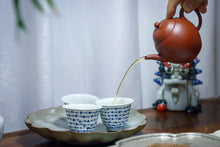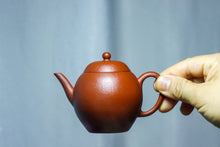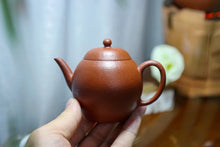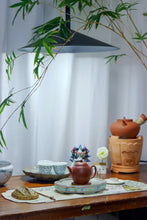
"Tea sets are the best in the world, and the model for appreciation lies in the hands of people." This is of course referring to Yixing purple clay teapots, and among them there is a type of small red clay teapot that is unique, which was popular in the Qing Dynasty and is still a classic today. Indeed, there is no big red clay teapot, and small teapots are popular all over the world. In the world of purple clay, which is fond of antiquity and simplicity, red clay teapots insist on being small and exquisite, and being elegant and beautiful. Yixing purple clay teapots are mainly made of purple clay, and red clay teapots, as a branch, are not to be underestimated. As early as the late Ming and early Qing dynasties in the 17th century, small red clay teapots had already branched out from the big tree of purple clay. First, they were exported to Europe, and then to the southeast coast of China, Japan, and Southeast Asia, and were called "red porcelain tea sets" by foreign tea lovers.
Among them, a group of famous red clay artists, represented by Hui Mengchen, Xu Hengmao, Hui Yigong, Lu Siting, Zhang Junde, Pan Shicheng, and Shao Baiyuan, emerged. Zhuni pots named after them, such as "Mengchen Pot", "Hengmao Dragon Egg", "Yigong Pot", "Siting Pot", "Junde Pot", "Pan Pot", etc., have been passed down from generation to generation.
Today, Tongxinshe Teahouse recommends that Mr. Ye Xiangkun make an ancient raw sand Zhuni teapot, a replica of the Qing Dynasty goose egg small teapot, 120cc, vermilion with orange light, good air permeability, and Tongxinshe Teahouse has only one collection.
Friends who often use purple clay pots to drink tea know that most of the Zhuni mines are not sand-forming, so Zhuni that can form sand is extremely rare.
Many famous Zhuni works in the Qing Dynasty in history used raw sand Zhuni. Compared with ordinary Zhuni, raw sand Zhuni has better air permeability and is the first choice for brewing tea. Zisha pots made of raw sand Zhuni have excellent air permeability and water absorption, but natural clay materials will inevitably have the phenomenon of "jumping sand", which is a natural phenomenon, and it also shows that the clay material is pure and has no acid washing.
Yungong goose egg is a classic Kung Fu teaware style, popular in the Qianlong period. With its unique shape and exquisite craftsmanship, it has become a shining pearl on the tea table. Its unique shape, as the name suggests, is like a standing goose egg, extending from the lid to the pot body, presenting a smooth arc transition, which is completed in one go and is breathtaking. The pot body is graceful and elegant, with a curved flow, like an elegant dancer. The handle is delicate and easy to hold. The pot knob is like a pearl bun, which adds a bit of elegance and delicacy. Every detail on the pot body, whether it is the roundness and smoothness of the pot body or the exquisiteness and smallness of the pot knob, reflects the essence of Chinese traditional culture and unique aesthetic perspective.
Many teapot lovers are proud to own a red clay teapot that is made of pure clay and fine workmanship. However, most of the red clays on the market appear very "clean" and "glossy" at first glance, but they do not change much after soaking. The beauty of the ancient raw sand red clay can only be revealed through daily soaking. The raw sand red clay is not very bright when it comes out of the kiln, but after daily soaking, its color becomes increasingly rosy and attractive. Moreover, most of the ancient Zhuni teapots have no wrinkles. The raw sand Zhuni is not slurried or acid-washed, the particles are natural and the air permeability is better. This is the traditional Zhuni that belongs to purple clay. The raw sand Zhuni is the core part of the Zhuni mine. It has a hard texture and sandy texture. After selection, it is directly sieved into powder without slurrying. From properties to refining technology, it is far superior to ordinary Zhuni, and thus restores the original texture and function of ancient purple clay teapots. It does not take away the fragrance of tea when brewing tea, has no smell of cooked soup, does not go bad over night in summer, is breathable and safe, and there is no need to warm the pot in winter. After firing, the raw sand Zhuni material presents a vermilion color with a slight orange glow. The Chinese red that dances on the Zhuni teapot can be called a touch of color on the tea table. Of course, more importantly, from a practical point of view, the purple clay teapot made of raw sand Zhuni is not picky about tea leaves, whether it is raw Pu'er, cooked Pu'er, or black tea, green tea, or old white tea, it is very suitable for it. In addition, raw sand cinnabar is more rare because it is raw sand and raw powder, shrinks more, is more difficult to make, and has a lower yield rate.
Zisha master Gu Jingzhou called traditional cinnabar "cinnabar clay", which shows that real cinnabar still has sandy properties, which is also in line with the general characteristics of purple sand. After the traditional raw material cinnabar is fired, the finished product looks simple, soft and charming, not bright and dazzling, but it becomes red when sprinkled with water, and the change after soaking is extremely obvious. The sand body is crystal bright, the patina is rich and layered, and the degree of moistness is like "mutton fat jade", which makes people love it.
Ye Xiangkun: Born in Yixing, Jiangsu in 1965, he is an older generation of purple sand craftsmen who cooperated with Taiwanese tea merchants and pot merchants earlier. It was also because of the early acceptance of the work of matching lids for old pots required by Taiwanese collectors that Mr. Ye got his hands on an astonishing number of ancient pots. Through copying and studying ancient pots, Mr. Ye is good at making red clay pieces with the charm of the three dynasties of Qing Dynasty. His pot-making techniques also strictly follow the ancient methods. Mr. Ye is very casual in making pots. He does not keep any size limits for each pot he makes, and the tools he uses to make pots are also extremely rare and of the same style.

























